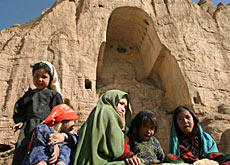Swiss heritage goes underground to survive

Deep in the Emmental region of canton Bern, Switzerland’s cultural heritage is preserved within a former army bunker.
The Heimiswil underground shelter, which was used by the military until 1970, now houses a huge archive of microfilms.
The federal archive holds around 54,000 films, containing records of historical and cultural importance dating from the late Middle Ages onwards. Newspapers, books and maps have all been given the microfilm treatment.
“The decision about which items are worth preserving and microfilming is based on the Swiss inventory of cultural property,” Rino Büchel, the secretary of the Swiss Committee for the Protection of Cultural Property, told swissinfo.
“Microfilm is an excellent medium for preserving valuable information, because it is space-saving and relatively cheap.
“If the temperature and relative humidity are kept at ten degrees Celsius and 35 per cent respectively, the films are expected to last for more than a century,” he added.
Valuable heritage
Büchel said that it was only when cultural property was destroyed that people realised how much it meant to them.
“The fire destroying the old wooden Chapel Bridge in Lucerne in August 1993, for instance, came as a great shock to the local population and made them feel that part of their surroundings and their identity had been taken away from them,” Büchel said.
The vast destruction of cultural sites in Europe during the Second World War and the sense that valuable heritage had been lost led to the Hague Convention for the Protection of Cultural Property in the Event of Armed Conflict signed in 1954.
In the light of changed warfare tactics since the Second World War, the Second Protocol to the Convention was drawn up and signed in 1999. It holds parties involved in systematically and intentionally destroying cultural heritage accountable for their deeds.
The 50th anniversary of the Hague convention is seen as an occasion to celebrate what has been achieved so far, but also to remind people of what still needs to be done.
Natural disasters
“The frequent occurrences of natural catastrophes – flooding, fires and earthquakes – in the recent past have sensitised the population to the vulnerability of cultural property,” Büchel said.
“After disaster has struck, people often try to save what is left, because it is these items and values they know and cherish and wish to pass on to future generations.”
The secretary of the Swiss Committee for the Protection of Cultural Property said that keeping an archive of microfilms was very important, as it allowed the retrieval of information, as well as the reconstruction of important sites.
He gave the example of the old bridge in the Bosnian town of Mostar that was intentionally destroyed during the war in 1993 so as to separate the Muslims and the Croats living on either side.
The bridge has now been rebuilt – a sign of reconciliation and hope that the two ethnic groups will come closer together. Reconstructing the bridge would not have been possible if there had not been any plans of the bridge available.
swissinfo
The federal microfilm archive of cultural property was opened in 1979.
It is located in a former bunker in Heimiswil, canton Bern, and consists of two rooms, one for working in and one for storing the films.
The archive measures 2,100 cubic metres, and holds 54,000 microfilms.
Microfilms are stored at a temperature of 10°C and at a relative humidity of 35%.
Records kept in the microfilm archive range from letters dating back to the late Middle Ages, newspapers, literary holdings and architectural maps from all Swiss cantons.

In compliance with the JTI standards
More: SWI swissinfo.ch certified by the Journalism Trust Initiative










You can find an overview of ongoing debates with our journalists here . Please join us!
If you want to start a conversation about a topic raised in this article or want to report factual errors, email us at english@swissinfo.ch.